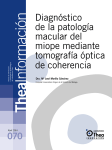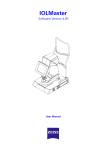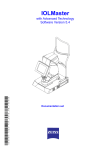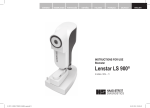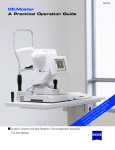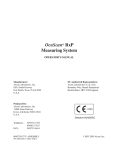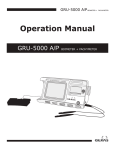Download Barr - Better Biometry notes
Transcript
Slide 1 ___________________________________ ___________________________________ ___________________________________ Jessica Barr, COMT, ROUB Clinical Supervisor The Children’s Hospital of Philadelphia Division of Ophthalmology Co-Director, COT Program Camden County College Ophthalmic Science ___________________________________ ___________________________________ ___________________________________ ___________________________________ Slide 2 ___________________________________ Discussion points Patient history ___________________________________ Keratometry IOL master Principles of ultrasound A-Scan biometry ___________________________________ ___________________________________ ___________________________________ ___________________________________ ___________________________________ Slide 3 ___________________________________ Patient history Did the patient have prior surgery? Lasik/PRK/Refractive procedures change keratometry measurements Retinal detachments – scleral buckling procedures elongate the eye 0.5mm to 1.0 mm Is the patient phakic? Pseudophakic? If so, what lens materials (Silicone, PMMA, Acrylic)? Aphakic? ___________________________________ ___________________________________ You will need to adjust the settings on IOL M. and/or A-scan Do they have a PK or corneal opacity? If you can’t see the retina, a B-Scan is always indicated and billable! ___________________________________ ___________________________________ ___________________________________ ___________________________________ Slide 4 ___________________________________ Patient history Key points for axial length measurements: Myopic eyes are generally longer Hyperopic eyes are generally shorter Average eye is 23.5mm long Keratometry measurements can explain emmetropia in a patient with unusual AL ___________________________________ ___________________________________ ___________________________________ ___________________________________ ___________________________________ ___________________________________ Slide 5 ___________________________________ Keratometry Auto-K’s vs. Manual K’s vs. IOL Master K’s????? ___________________________________ Standardize your K readings! Manual K’s are the least reproducible amongst biometrists Pick a method and stick with it! ___________________________________ Always use two methods for K’s to verify the validity of the measurements. ___________________________________ ___________________________________ ___________________________________ ___________________________________ Slide 6 ___________________________________ Keratometry - Manual Uncorrected refractive error of the examiner WILL result in erroneous measurements. ALWAYS focus your eye piece FIRST! ALWAYS keep the fellow eye OPEN while measuring Focus the horizontal meridian mires first, then measure. You can re-focus the mires now to take the vertical measurements. ___________________________________ ___________________________________ Especially important for highly astigmatic patients Key point: 1D error in keratometry reading will result in 1D post-op refractive error ___________________________________ ___________________________________ ___________________________________ ___________________________________ Slide 7 ___________________________________ Keratometry The two eyes should be with in 1D of each other ___________________________________ Long eyes usually have flat K’s Short eyes usually have steep K’s Average K reading is 43-44D ___________________________________ ___________________________________ ___________________________________ ___________________________________ ___________________________________ Slide 8 ___________________________________ Keratometry Soft lenses should be out for about a week ___________________________________ Gas perm lenses or hard lenses should be out until the K’s are stable! ___________________________________ ___________________________________ ___________________________________ ___________________________________ ___________________________________ Slide 9 ___________________________________ IOL Master Axial length ___________________________________ Keratometry ACD White to white Formulas: Haigis, HofferQ, Holladay, SRK II, SRK/T Can be linked to Holladay II program and other network systems ___________________________________ ___________________________________ ___________________________________ ___________________________________ ___________________________________ Slide 10 ___________________________________ IOL Master Measuring Axial length: It is useful to take all 20 measurements. At least four of these measurements should be within 0.02 mm of one another, and should exhibit the characteristics of an Ideal Display. An ideal axial length display is more important than a high signal-to-noise ratio (SNR). ___________________________________ ___________________________________ ___________________________________ ___________________________________ ___________________________________ ___________________________________ Slide 11 ___________________________________ IOL Master Reasons for Low Signal-to-Noise Ratio: Dense medial opacity along the visual axis Restless patient Alignment of device to patient eye is not optimal Very high ammetropia (> 6 D) Corneal scars Pathologic changes in the retina. ___________________________________ ___________________________________ ___________________________________ ___________________________________ ___________________________________ ___________________________________ Slide 12 ___________________________________ IOL Master Troubleshooting: Adjust the joystick, try scanning in all 4 quadrants of the circle Pull back or push forward– de-focus the reflecting light to fill the entire circle Observe- sometimes you can see where the opacity is and try to scan around it ___________________________________ ___________________________________ ___________________________________ ___________________________________ ___________________________________ ___________________________________ Slide 13 ___________________________________ IOL Master ___________________________________ ___________________________________ Did you know? You can take measurements with the patient wearing their glasses. This can improve fixation in patients with high refractive errors and will not interfere with AL measurements ___________________________________ ___________________________________ ___________________________________ ___________________________________ Slide 14 ___________________________________ IOL Master Key Points: Don’t be a button pusher! Understand the information you’re getting. Read the manual! Instruct the patient. 80-90% of patients can be scanned ___________________________________ ___________________________________ What about the other 10-20%? ___________________________________ ___________________________________ ___________________________________ ___________________________________ Slide 15 ___________________________________ Ultrasound Measured in hertz: One hertz is one cycle per second The human ear hears sounds 20Hz – 20,000Hz ___________________________________ Ultrasound has a frequency of >20,000Hz Ophthalmic ultrasound uses a frequency of approximately 10,000,000 hertz (10Mhz) Higher frequency means less penetration but greater resolution ___________________________________ ___________________________________ ___________________________________ ___________________________________ ___________________________________ Slide 16 ___________________________________ Ultrasound ___________________________________ ___________________________________ ___________________________________ ___________________________________ ___________________________________ ___________________________________ Slide 17 ___________________________________ Ultrasound ___________________________________ ___________________________________ ___________________________________ ___________________________________ ___________________________________ ___________________________________ Slide 18 ___________________________________ Ultrasound - Contact ___________________________________ ___________________________________ ___________________________________ ___________________________________ ___________________________________ ___________________________________ Slide 19 ___________________________________ Ultrasound - Contact Oops! ___________________________________ ___________________________________ ___________________________________ ___________________________________ ___________________________________ ___________________________________ Slide 20 ___________________________________ Ultrasound - Contact Corneal compression! This is inaccurate even in the hands of the experienced biometrist Compression is UNAVOIDABLE. Studies show the contact method compresses the cornea 0.14mm-0.36mm Compression varies with IOP and corneal thickness We can’t predict or control this! ___________________________________ ___________________________________ ___________________________________ ___________________________________ ___________________________________ ___________________________________ Slide 21 ___________________________________ Ultrasound – Contact Fluid bridge measures the eye erroneously long ___________________________________ ___________________________________ ___________________________________ ___________________________________ ___________________________________ ___________________________________ Slide 22 ___________________________________ Ultrasound - Contact “There is really scant defense for applanation anymore given the refractive demands of our cataract patients, our refractive lens exchange patients and even more so, the patients who have already had refractive surgery once.” “Along with the immersion ultrasound technique, partial coherence interferometry has rendered the applanation method obsolete when calculating a highly accurate IOL power is the goal.” ___________________________________ ___________________________________ ___________________________________ Ophthalmology Management April 2005 “Sizing Up Your Biometry Options” ___________________________________ ___________________________________ ___________________________________ Slide 23 ___________________________________ Ultrasound - Immersion ___________________________________ ___________________________________ ___________________________________ ___________________________________ ___________________________________ ___________________________________ Slide 24 ___________________________________ Ultrasound - Immersion Hansen shells – Various sizes ___________________________________ 16mm, 18mm, 20mm, 22mm, 24mm Patient must be reclined ___________________________________ ___________________________________ ___________________________________ ___________________________________ ___________________________________ Slide 25 ___________________________________ Ultrasound - Immersion Prager shell Not position dependent Probe locks in place ___________________________________ ___________________________________ ___________________________________ ___________________________________ ___________________________________ ___________________________________ Slide 26 ___________________________________ Ultrasound – Immersion 4 gates, 5-6 spikes Cornea (2), anterior lens, posterior lens, retina, sclera ___________________________________ ___________________________________ ___________________________________ Poor screen resolution Better screen resolution ___________________________________ ___________________________________ ___________________________________ Slide 27 ___________________________________ Ultrasound - Gates Gates MUST be on the ascending edge of spike ___________________________________ ___________________________________ ___________________________________ A-Scan Biometry, Rhonda Waldron ___________________________________ ___________________________________ ___________________________________ Slide 28 ___________________________________ Ultrasound – Gates ___________________________________ Always check the gate placement – incorrect placement means incorrect measurements ___________________________________ ___________________________________ ___________________________________ ___________________________________ ___________________________________ Slide 29 ___________________________________ Ultrasound – Velocity Cornea 1,641 m/s ___________________________________ Aqueous 1,532 m/s Lens 1,641 m/s ___________________________________ Vitreous 1,532 m/s Average 1,550 m/s PMMA 2,718 m/s ___________________________________ Acrylic 2,120 m/s Silicone 980-1100 m/s ___________________________________ ___________________________________ ___________________________________ Slide 30 ___________________________________ Ultrasound - Pseudophakia Find out what type of lens they had implanted – Maybe the patient actually kept the lens card? Maybe not… The various lens materials have unique spike patterns ___________________________________ ___________________________________ ___________________________________ PMMA Acrylic A-Scan Biometry, Rhonda Waldron ___________________________________ ___________________________________ ___________________________________ Slide 31 ___________________________________ Ultrasound – Gain When do you adjust the gain? Turn the gain up for dense cataracts that are yielding a poorly rising retinal spike Turn the gain down for pseudophakic scans to reduce reverberating spikes Use CAUTION when adjusting the gain! Only adjust as much as is needed to get the scan ___________________________________ ___________________________________ ___________________________________ ___________________________________ ___________________________________ ___________________________________ Slide 32 ___________________________________ Ultrasound – Gain Too high Erroneously short measurement Extra noise = extra spikes = incorrect gate placement ___________________________________ ___________________________________ ___________________________________ ___________________________________ ___________________________________ ___________________________________ Slide 33 ___________________________________ Ultrasound - Gain Too low Erroneously long measurement Low amplitude spikes ___________________________________ ___________________________________ ___________________________________ ___________________________________ ___________________________________ ___________________________________ Slide 34 ___________________________________ Ultrasound – Pattern The most important thing about your A-Scan eye length measurements is the PATTERN OF YOUR SCAN ___________________________________ Standard deviation means nothing if you do you not have the correct pattern It is entirely possible to get multiple erroneous measurements with good standard deviation – BUT – the pattern is wrong! Do NOT be misled by reproducibility if you have any doubts about the pattern of your scan. Ten bad scans with the same axial length are just ten bad scans. Pattern trumps reproducibility. ___________________________________ ___________________________________ ___________________________________ ___________________________________ ___________________________________ Slide 35 ___________________________________ Ultrasound – Troubleshooting Can’t get a steeply rising retina spike? Misalignment of the sound beam Localizing the macula Posterior staphyloma Macular pathology ___________________________________ ___________________________________ ___________________________________ ___________________________________ ___________________________________ ___________________________________ Slide 36 ___________________________________ Ultrasound – Troubleshooting You must be perpendicular to the visual axis Retina spike MUST BE 90 degrees angle from the baseline and steeply rising ___________________________________ ___________________________________ ___________________________________ ___________________________________ ___________________________________ ___________________________________ Slide 37 ___________________________________ Ultrasound– Misalignment A beautiful A-Scan with no scleral spike is a bad measurement YOU ARE MEASURING TO THE OPTIC NERVE ___________________________________ ___________________________________ This eye is actually 22.72mm long when measured to the macula ___________________________________ ___________________________________ ___________________________________ ___________________________________ Slide 38 ___________________________________ Ultrasound – Localizing the Macula Point the probe nasally until you see the previous pattern without a scleral spike– Now you know where you are. Tilt the probe temporally until you see a sharply rising and clearly defined scleral spike Hello Macula! ___________________________________ ___________________________________ ___________________________________ ___________________________________ ___________________________________ ___________________________________ Slide 39 ___________________________________ Ultrasound – Posterior Staphyloma Irregular contour of the staphyloma impairs reflectivity of sound ___________________________________ ___________________________________ ___________________________________ ___________________________________ ___________________________________ ___________________________________ Slide 40 ___________________________________ Ultrasound – Posterior Staphyloma IOL Master measures these eyes most accurately Consider B biometry in conjunction with A-Scan ___________________________________ ___________________________________ ___________________________________ ___________________________________ ___________________________________ ___________________________________ Slide 41 ___________________________________ Ultrasound – Macular Pathology An eye with a macular pathology may yield poor quality retinal spike (AMD, VMT, ERM, RD) The prognosis and treatment plan may change. ___________________________________ ___________________________________ ___________________________________ ___________________________________ ___________________________________ ___________________________________ Slide 42 ___________________________________ Ultrasound – Mac off RD ___________________________________ ___________________________________ FYI – If a patient has an RD that will require scleral buckling along with CE/IOL is it appropriate to add 0.75mm to the axial length since SB’s will elongate an eye 0.5mm-1.0mm ___________________________________ ___________________________________ ___________________________________ ___________________________________ Slide 43 ___________________________________ Ultrasound- Sources of Error Byrne, SF. A-Scan Axial Eye Length Measurements Causes of a short measurement: Air bubble adherent to the transducer in a water filled probe Corneal compression(contact method) Sound velocity is too slow Corneal gate to the right of the corneal spike Retinal gate too far left of the retinal spike Gain set too high Lens measured too thin Misalignment of the sound beam ___________________________________ ___________________________________ ___________________________________ ___________________________________ ___________________________________ ___________________________________ Slide 44 ___________________________________ Ultrasound- Sources of Error Byrne, SF. A-Scan Axial Eye Length Measurements Causes of a long measurement: Air bubble in the fluid bath (immersion) Fluid bridge (contact method) Sound velocity too fast Retinal gate to the right of the retinal spike Gain set too low Lens measure too thick Misalignment of the sound beam ___________________________________ ___________________________________ ___________________________________ ___________________________________ ___________________________________ ___________________________________ Slide 45 ___________________________________ Standard Dimensions– Axial Length Average eye ranges 22.0mm to 24.5mm Measurements for the same eye should be within 0.2mm The two eyes should be within 0.3mm of each other Any disparity needs to be explained. BOTH eyes should ALWAYS be measured for comparative purposes 0.1mm in an average eye is equal to approx 0.25D This is more significant in a short eye and less significant in a long eye Post op refractive errors: If eye measured too short then post op myopic error If eye measure too long then post op hyperopic error ___________________________________ ___________________________________ ___________________________________ ___________________________________ ___________________________________ ___________________________________ Slide 46 ___________________________________ Standard Dimensions Average ACD 3.24mm ___________________________________ Average lens thickness 4.6mm – Will increase with progression of cataract K’s 43-44D Should be within 1D of each other White to white 11.7mm +/-0.46mm ___________________________________ ___________________________________ ___________________________________ ___________________________________ ___________________________________ Slide 47 ___________________________________ Hyperopia ___________________________________ Right eye Left eye MR +3.50 +1.25 x 025 MR +3.75 +1.75 x 130 Axial length 21.37mm Axial length 21.27mm K’s 44.00/45.50 K’s 43.75/45.25 ___________________________________ MR +2.50 +1.50 x 015 MR +2.75 + 1.00 x 165 Axial length 24.00mm Axial Length 23.85 K’s 41.37/39.75 K’s 41.62/40.12 ___________________________________ ___________________________________ ___________________________________ ___________________________________ Slide 48 ___________________________________ Myopia ___________________________________ Right eye Left eye MR -6.00 + 1.00 x 135 MR -5.75 + 0.75 x 045 Axial length 27.33mm Axial length 27.47 K’s 43.00/44.37 K’s 43.50/44.50 ___________________________________ MR -8.00 + 2.75 x 090 MR -8.50 + 2.25 x 090 Axial length 23.30mm Axial length 23.50mm K’s 48.25/50.00 K’s 48.12/49.75 ___________________________________ ___________________________________ ___________________________________ ___________________________________ Slide 49 ___________________________________ Emmetropia ___________________________________ Right eye Left eye MR plano +.50 x 022 MR +0.25 +0.25 x 157 Axial length 22.24mm Axial length 22.33mm K’s 45.50/45.87 K’s 45.37/45.25 ___________________________________ MR plano MR plano Axial length 24.92 Axial length 25.02 K’s 42.00/41.87 K’s 41.75/42.12 ___________________________________ ___________________________________ ___________________________________ ___________________________________ Slide 50 ___________________________________ Resources ___________________________________ ___________________________________ ___________________________________ ___________________________________ ___________________________________ ___________________________________ Slide 51 ___________________________________ Resources The Ophthalmic Biometrist ___________________________________ Fort Lauderdale 2008, Philadelphia 2011 Rhonda G. Waldron MMSc, COMT, CRA, ROUB, CDOS Diagnostic Echographer, Senior Associate in Ophthalmology Emory Eye Center, Atlanta GA Owner, Eye Scan Consulting [email protected] Phone (404) 286-9067 A-Scan Biometry, Rhonda Waldron http://emedicine.medscape.com/article/1228447-overview ___________________________________ ___________________________________ ___________________________________ ___________________________________ ___________________________________ Slide 52 ___________________________________ Resources Warren E. Hill, MD, FACS http://doctor-hill.com/ Biometry IOL master ___________________________________ ___________________________________ Formulas Optimization Post refractive calculations Great for techs and physicians ___________________________________ ___________________________________ ___________________________________ ___________________________________ Slide 53 ___________________________________ References Devgan, U. (September/October 2011). Cataract Surgery in Small Eyes. Premier Surgeon, 10-11. ___________________________________ Farrell, T. (May 2009). Precision Biometry. Ophthalmology Management. Parkinson, J. (April 2005). Sizing Up Your Biometry Options. Ophthalmology Management. Savini, G., Hoffer, K. J., & Zanini, M. (April 2007). IOL Power Calculations After LASIK and PRK. Cataract and Refractive Surgery Today - Europe, 37-44. Shammas, H. J. (2004). Intraocular Lens Power Calculations. Thorofare New Jersey: SLACK Incorporated. Tyson, F. (August 2006). Choosing the Proper Formula for Accurate IOL Calculations. Ophthalmology Management. Zeiss IOL Master User Manual, Software 5.xx, ___________________________________ ___________________________________ ___________________________________ ___________________________________ ___________________________________


















